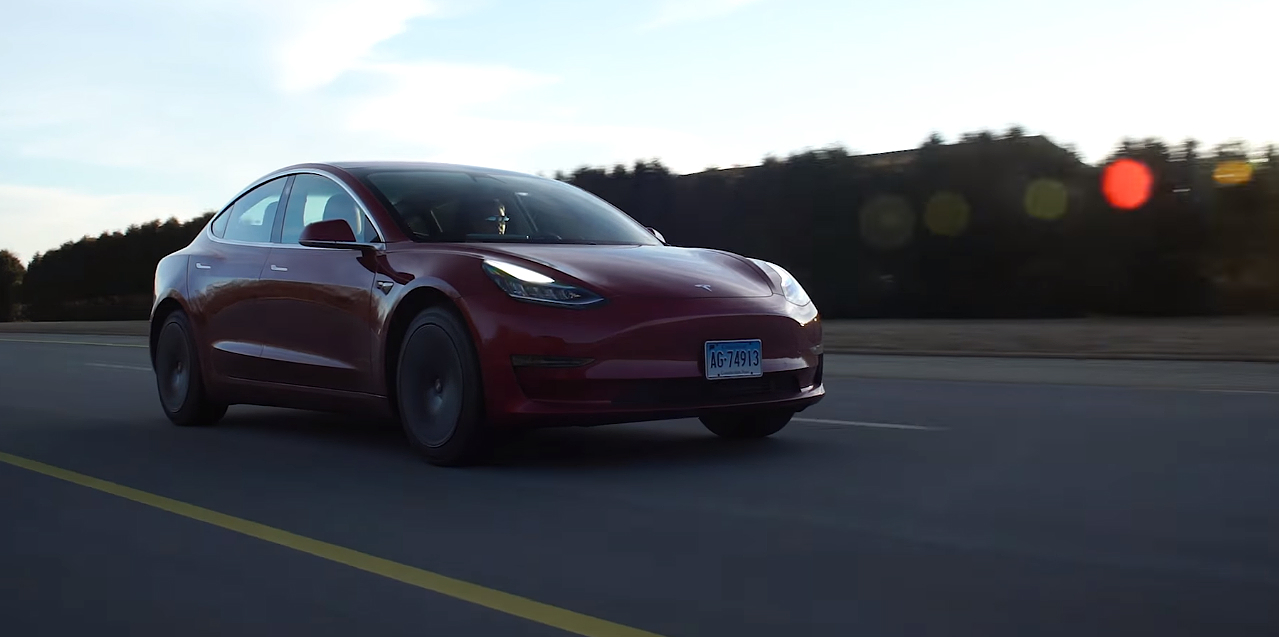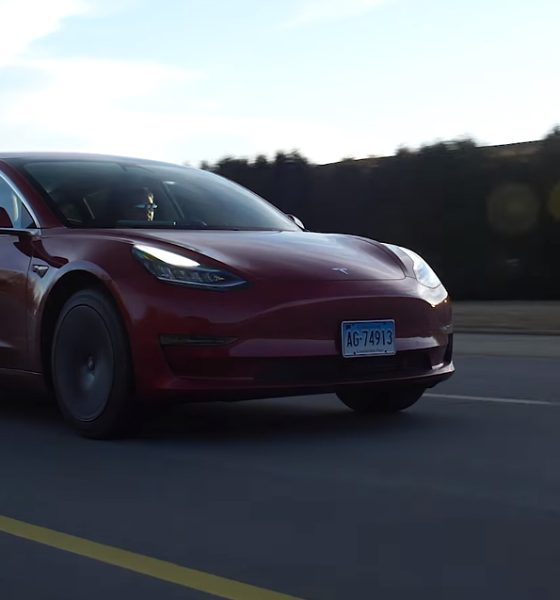

News
Elon Musk spoke with Consumer Reports following Tesla Model 3 test results
In a recent episode of Consumer Reports’ Talking Cars, Auto Test Director Jake Fisher recounted a conversation he had with Tesla CEO Elon Musk following the release of CR’s test results for the Model 3.
While the magazine stated that there was “plenty to like” about the electric car, such as its excellent range and handling, there were several aspects of the vehicle that left much to be desired. The most prominent of the Model 3’s shortcomings were the car’s brakes, which had an average stopping distance of 152 feet from 60-0 mph — longer than any vehicle in its class. Due to its shortcomings, Consumer Reports opted not to give the Model 3 a “Recommended” rating.
Musk promptly responded to the magazine’s findings on Twitter, stating that Tesla would address the Model 3’s braking issues in an over-the-air firmware update. Musk also pledged to continuously improve the Model 3’s brakes, saying that “Tesla won’t stop until Model 3 has better braking than any remotely comparable car.”
As revealed in Consumer Reports’ recent Talking Cars episode, Musk also reached out to Auto Test Director Jake Fisher after the magazine’s test results were published. During their conversation, Musk and Fisher discussed the Model 3 and possible improvements to the vehicle.
“He was remarkably candid about things. Honestly, he actually thanked us for bringing these things to attention, and said that we’re helping him make the car better,” Fisher said.
Fisher noted that he and Musk talked about several of the Model 3’s deficiencies, such as its controls, brakes, wind noise, rear seats, and its suspension. According to the CR Auto Test Director, Musk stated that Tesla has implemented improvements to the Model 3’s design over the past few months.
During the March-April timeframe, for one, Tesla rolled out changes to the Model 3’s glass to adjust wind noise in the cabin. Around the same time, Tesla also made modifications to the suspension, such as its shock absorbers, to make the ride more comfortable.
Musk discussed the controls of the Model 3 as well, a particular aspect of the vehicle that was considered as a weakness in Consumer Reports’ evaluation. According to Fisher, Musk threw out some ideas to make the car’s controls better.
“We talked about the vents, and he talked about ideas of, well, maybe as you move the seat, (the Model 3) would automatically adjust the vents and the mirrors to suit you,” Fisher said.

Consumer Reports recently published the results of its tests for the Model 3. [Credit: Consumer Reports/YouTube]
Musk also discussed another one of Consumer Reports’ complaints about the Model 3 — the car’s keycard. During its testing, the magazine noted that the phone key worked very well with the Model 3, but using the keycard proved cumbersome. Musk addressed this issue during his phone conversation with Fisher as well.
“He (Musk) admitted that yeah, this isn’t working too well, and we really should do something better. Again, I don’t know if they’re gonna do it or not, but he said we really need to provide a normal key to the customers of this car,” Fisher said.
The Model 3’s keycard stands as one of its differences with its larger siblings, the Model S and the Model X, both of which use Tesla’s ubiquitous electric car-shaped key fobs. The keycard, which is credit card-sized for easy storing in a wallet, is embedded with a small chip that acts as a digital signature for the vehicle.
Since the Model 3 keycard uses near field communication (NFC) technology, the card has a limited transmission range of about 4 inches, requiring owners to tap the electric car’s B-pillar to unlock the door. The card is also placed between the front seats of the vehicle to start the car.
Consumer Reports has been mixed with Tesla’s vehicles so far. The magazine dubbed the Model S as the best car it ever tested. The Model X, on the other hand, was dubbed by CR “fast and flawed,” citing the overcomplicated Falcon Wing Doors of the all-electric luxury SUV. Despite its reservations with the Model X, however, Consumer Reports nevertheless ranked Tesla as the sole American automaker in its Top 10 list for 2018.
Watch Consumer Reports’ recent episode on the Tesla Model 3 in the video below.

News
Tesla FSD fleet is nearing 7 billion total miles, including 2.5 billion city miles
As can be seen on Tesla’s official FSD webpage, vehicles equipped with the system have now navigated over 6.99 billion miles.

Tesla’s Full Self-Driving (Supervised) fleet is closing in on almost 7 billion total miles driven, as per data posted by the company on its official FSD webpage.
These figures hint at the massive scale of data fueling Tesla’s rapid FSD improvements, which have been quite notable as of late.
FSD mileage milestones
As can be seen on Tesla’s official FSD webpage, vehicles equipped with the system have now navigated over 6.99 billion miles. Tesla owner and avid FSD tester Whole Mars Catalog also shared a screenshot indicating that from the nearly 7 billion miles traveled by the FSD fleet, more than 2.5 billion miles were driven inside cities.
City miles are particularly valuable for complex urban scenarios like unprotected turns, pedestrian interactions, and traffic lights. This is also the difference-maker for FSD, as only complex solutions, such as Waymo’s self-driving taxis, operate similarly on inner-city streets. And even then, incidents such as the San Francisco blackouts have proven challenging for sensor-rich vehicles like Waymos.
Tesla’s data edge
Tesla has a number of advantages in the autonomous vehicle sector, one of which is the size of its fleet and the number of vehicles training FSD on real-world roads. Tesla’s nearly 7 billion FSD miles then allow the company to roll out updates that make its vehicles behave like they are being driven by experienced drivers, even if they are operating on their own.
So notable are Tesla’s improvements to FSD that NVIDIA Director of Robotics Jim Fan, after experiencing FSD v14, noted that the system is the first AI that passes what he described as a “Physical Turing Test.”
“Despite knowing exactly how robot learning works, I still find it magical watching the steering wheel turn by itself. First it feels surreal, next it becomes routine. Then, like the smartphone, taking it away actively hurts. This is how humanity gets rewired and glued to god-like technologies,” Fan wrote in a post on X.
News
Tesla starts showing how FSD will change lives in Europe
Local officials tested the system on narrow country roads and were impressed by FSD’s smooth, human-like driving, with some calling the service a game-changer for everyday life in areas that are far from urban centers.

Tesla has launched Europe’s first public shuttle service using Full Self-Driving (Supervised) in the rural Eifelkreis Bitburg-Prüm region of Germany, demonstrating how the technology can restore independence and mobility for people who struggle with limited transport options.
Local officials tested the system on narrow country roads and were impressed by FSD’s smooth, human-like driving, with some calling the service a game-changer for everyday life in areas that are far from urban centers.
Officials see real impact on rural residents
Arzfeld Mayor Johannes Kuhl and District Administrator Andreas Kruppert personally tested the Tesla shuttle service. This allowed them to see just how well FSD navigated winding lanes and rural roads confidently. Kruppert said, “Autonomous driving sounds like science fiction to many, but we simply see here that it works totally well in rural regions too.” Kuhl, for his part, also noted that FSD “feels like a very experienced driver.”
The pilot complements the area’s “Citizen Bus” program, which provides on-demand rides for elderly residents who can no longer drive themselves. Tesla Europe shared a video of a demonstration of the service, highlighting how FSD gives people their freedom back, even in places where public transport is not as prevalent.
What the Ministry for Economic Affairs and Transport says
Rhineland-Palatinate’s Minister Daniela Schmitt supported the project, praising the collaboration that made this “first of its kind in Europe” possible. As per the ministry, the rural rollout for the service shows FSD’s potential beyond major cities, and it delivers tangible benefits like grocery runs, doctor visits, and social connections for isolated residents.
“Reliable and flexible mobility is especially vital in rural areas. With the launch of a shuttle service using self-driving vehicles (FSD supervised) by Tesla in the Eifelkreis Bitburg-Prüm, an innovative pilot project is now getting underway that complements local community bus services. It is the first project of its kind in Europe.
“The result is a real gain for rural mobility: greater accessibility, more flexibility and tangible benefits for everyday life. A strong signal for innovation, cooperation and future-oriented mobility beyond urban centers,” the ministry wrote in a LinkedIn post.
News
Tesla China quietly posts Robotaxi-related job listing
Tesla China is currently seeking a Low Voltage Electrical Engineer to work on circuit board design for the company’s autonomous vehicles.

Tesla has posted a new job listing in Shanghai explicitly tied to its Robotaxi program, fueling speculation that the company is preparing to launch its dedicated autonomous ride-hailing service in China.
As noted in the listing, Tesla China is currently seeking a Low Voltage Electrical Engineer to work on circuit board design for the company’s autonomous vehicles.
Robotaxi-specific role
The listing, which was shared on social media platform X by industry watcher @tslaming, suggested that Tesla China is looking to fill the role urgently. The job listing itself specifically mentions that the person hired for the role will be working on the Low Voltage Hardware team, which would design the circuit boards that would serve as the nervous system of the Robotaxi.
Key tasks for the role, as indicated in the job listing, include collaboration with PCB layout, firmware, mechanical, program management, and validation teams, among other responsibilities. The role is based in Shanghai.
China Robotaxi launch
China represents a massive potential market for robotaxis, with its dense urban centers and supportive policies in select cities. Tesla has limited permission to roll out FSD in the country, though despite this, its vehicles have been hailed as among the best in the market when it comes to autonomous features. So far, at least, it appears that China supports Tesla’s FSD and Robotaxi rollout.
This was hinted at in November, when Tesla brought the Cybercab to the 8th China International Import Expo (CIIE) in Shanghai, marking the first time that the autonomous two-seater was brought to the Asia-Pacific region. The vehicle, despite not having a release date in China, received a significant amount of interest among the event’s attendees.








